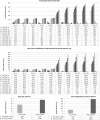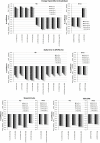Influence of Epoch Length and Recording Site on the Relationship Between Tri-Axial Accelerometry-Derived Physical Activity Levels and Structural, Functional, and Hemodynamic Properties of Central and Peripheral Arteries
- PMID: 35280222
- PMCID: PMC8909126
- DOI: 10.3389/fspor.2022.799659
Influence of Epoch Length and Recording Site on the Relationship Between Tri-Axial Accelerometry-Derived Physical Activity Levels and Structural, Functional, and Hemodynamic Properties of Central and Peripheral Arteries
Abstract
Background: It remains to be established to what extent physical activity (PA) levels among individuals are independently associated with deviations from the "optimal" state of the arterial system. Accelerometers have been proposed as means to obtain reliable, objective, and more comprehensive data of PA. Decisions at the time of data collection/processing could influence the association between accelerometry-derived indices and arterial properties.
Objectives: (i) To identify to what extent the strength of association between arterial properties and accelerometer-derived indices depend on the recording site and/or the epoch length; (ii) to determine whether some arterial characteristics (hemodynamic vs. structural vs. functional) or regions (elastic vs. transitional vs. muscular arteries; central vs. peripheral) have higher levels of association with accelerometry-derived indices.
Methods: Physical activity (PA), cardiovascular risk factors (CRFs), and cardiovascular properties were evaluated in 60 volunteers (general population; age: 23-62 years; women: 43%). PA was measured daily for 7 days (free-living situation; triaxial-accelerometers ActiGraph-GT3X+; hip and wrist; "Worn-to-wrist" option) and raw data was converted at epoch lengths of 1, 5, 10, 30, and 60-s. PA-related energy expenditure, daily time in moderate-to-vigorous PA, steps/minute, and counts-per-minute for vector magnitude were calculated. The cardiovascular evaluation included hemodynamic (central and peripheral pressure), structural (diameters and intima-media thickness), and functional (local and regional stiffness) parameters of carotids, femoral, and brachial arteries, and carotid-femoral and carotid-radial pathways. Arterial z-scores were obtained using age-related equations derived from healthy participants not exposed to CRFs (n = 1,688; age: 2-84 years; female: 51.2%) to evaluate at which degree each parameter deviates from the "optimal" value.
Methods: In general, hip recordings outperformed those obtained on the wrist regarding the strength of association with arterial parameters. Accelerometer-derived indices and their association with arterial properties vary depending on the recording site and epoch length. PA indices are stronger associated with functional (local) than structural variables and with central than peripheral arteries.
Conclusions: Regardless of the PA index, there were independent associations with central artery characteristics, which reinforces that these territories would be the most related to PA levels. Differences in data acquisition and processing could lead to differences in conclusions when addressing the association between accelerometer-derived indices and the cardiovascular system.
Keywords: accelerometry; arterial system; cardiovascular; epoch lengths; hip; physical activity; recording site; worn on wrist option (ActiLife software).
Copyright © 2022 Gómez-García, Torrado, Bia and Zócalo.
Conflict of interest statement
The authors declare that the research was conducted in the absence of any commercial or financial relationships that could be construed as a potential conflict of interest.
Figures





Similar articles
-
Physical Activity, Sedentary Behavior and Sleep Time:Association with Cardiovascular Hemodynamic Parameters, Blood Pressure and Structural and Functional Arterial Properties in Childhood.J Cardiovasc Dev Dis. 2021 May 31;8(6):62. doi: 10.3390/jcdd8060062. J Cardiovasc Dev Dis. 2021. PMID: 34072999 Free PMC article.
-
Measurement of Physical Activity with Wrist-Worn ActiGraph GT3X+ in Older Women.Int J Exerc Sci. 2022 Nov 1;15(7):1538-1553. doi: 10.70252/DJFQ6358. eCollection 2022. Int J Exerc Sci. 2022. PMID: 36618018 Free PMC article.
-
Aging-Related Moderation of the Link Between Compliance With International Physical Activity Recommendations and the Hemodynamic, Structural, and Functional Arterial Status of 3,619 Subjects Aged 3-90 Years.Front Sports Act Living. 2022 Feb 21;4:800249. doi: 10.3389/fspor.2022.800249. eCollection 2022. Front Sports Act Living. 2022. PMID: 35265833 Free PMC article.
-
Advances in accelerometry for cardiovascular patients: a systematic review with practical recommendations.ESC Heart Fail. 2020 Oct;7(5):2021-2031. doi: 10.1002/ehf2.12781. Epub 2020 Jul 3. ESC Heart Fail. 2020. PMID: 32618431 Free PMC article.
-
A Mapping Review of Physical Activity Recordings Derived From Smartphone Accelerometers.J Phys Act Health. 2020 Oct 7;17(11):1184-1192. doi: 10.1123/jpah.2020-0041. J Phys Act Health. 2020. PMID: 33027761 Review.
Cited by
-
The effects of pedometer-based exercise on central and peripheral vascular functions among young sedentary men with CVD risk factors.Front Physiol. 2023 Mar 28;14:1062751. doi: 10.3389/fphys.2023.1062751. eCollection 2023. Front Physiol. 2023. PMID: 37057183 Free PMC article.
-
Fat-Free Mass Index, Visceral Fat Level, and Muscle Mass Percentage Better Explain Deviations From the Expected Value of Aortic Pressure and Structural and Functional Arterial Properties Than Body Fat Indexes.Front Nutr. 2022 Apr 29;9:856198. doi: 10.3389/fnut.2022.856198. eCollection 2022. Front Nutr. 2022. PMID: 35571946 Free PMC article.
-
Effect of Data Reduction Techniques on Daily Moderate to Vigorous Physical Activity Collected with ActiGraph® in People with COPD.J Clin Med. 2023 Aug 16;12(16):5340. doi: 10.3390/jcm12165340. J Clin Med. 2023. PMID: 37629381 Free PMC article.
References
-
- ActiGraph (2019). User Guide ActiGraph wGT3X-BT + ActiLife Acti-Graph wGT3X-BT + ActiLife. Retrieved from: https://s3.amazonaws.com/actigraphcorp.com/wp-content/uploads/2019/02/04... (accessed October 20, 2021).
-
- ActiGraph (2021). ActiGraph. What Does the ‘Worn on Wrist' Option Do in the Scoring Tab? Available online at: https://actigraphcorp.force.com/support/s/article/What-does-the-Worn-on-... (accessed April 06, 2020).
LinkOut - more resources
Full Text Sources

